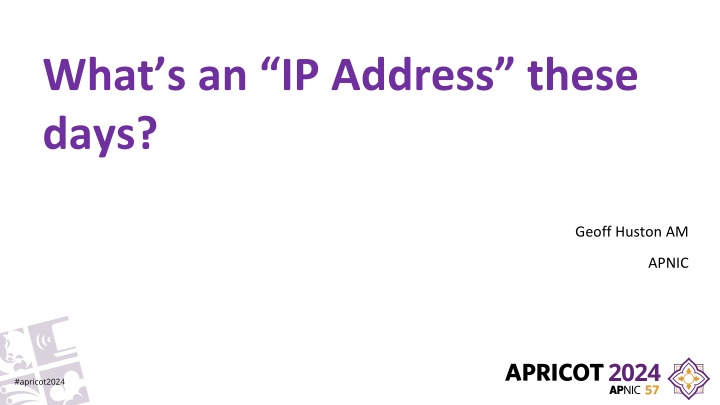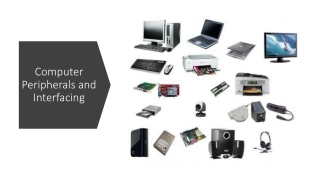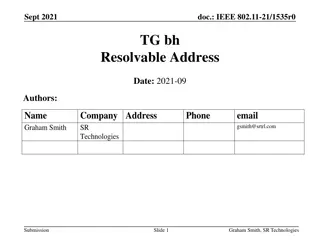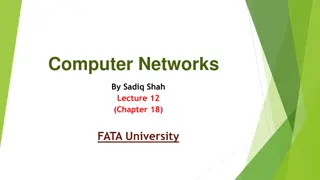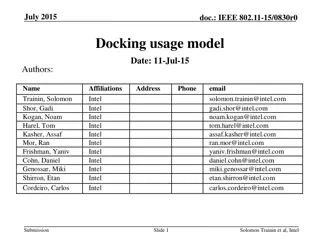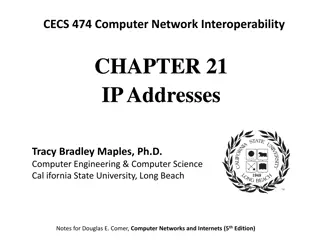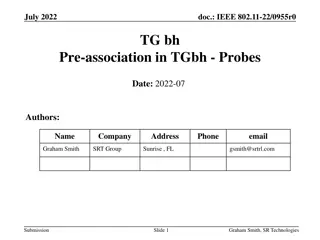Evolution of IP Addresses and Connected Devices
The evolution of IP addresses, connected devices, and network scalability is explored, highlighting the challenges faced and solutions implemented such as address scarcity and NATs. The need for unique addresses, location association, and reachability is emphasized in managing the growing network landscape.
Download Presentation

Please find below an Image/Link to download the presentation.
The content on the website is provided AS IS for your information and personal use only. It may not be sold, licensed, or shared on other websites without obtaining consent from the author.If you encounter any issues during the download, it is possible that the publisher has removed the file from their server.
You are allowed to download the files provided on this website for personal or commercial use, subject to the condition that they are used lawfully. All files are the property of their respective owners.
The content on the website is provided AS IS for your information and personal use only. It may not be sold, licensed, or shared on other websites without obtaining consent from the author.
E N D
Presentation Transcript
Whats an IP Address these days? Geoff Huston AM APNIC
Connected Devices Connected IoT device count 2019 - 2030 https://www.statista.com/statistics/1183457/iot-connected-devices-worldwide/
Addresses for Connected Devices Advertised Host Addresses 2019 - 2030 Connected IoT device count 2019 - 2030 https://www.statista.com/statistics/1183457/iot-connected-devices-worldwide/ APNIC Data Projections
Addresses for Connected Devices Advertised Host Addresses 2019 - 2030 Connected IoT device count 2019 - 2030 How are we bridging this widening gap? https://www.statista.com/statistics/1183457/iot-connected-devices-worldwide/ APNIC Data Projections
What did we need from Addresses? Identity: WHO - Every unique end point has a unique address value Location: WHERE - Every unique address is associated with a location within the network Reachability: HOW Every address informs the network how to direct packets towards it
What did we need from Addresses? Identity: WHO - Every unique end point has a unique address value Location: WHERE - Every unique address is associated with a location within the network Reachability: HOW Every address informs the network how to direct packets towards it
Running Short of Addresses Address scarcity has been a feature of public Internet services from the outset sharing a dial-up modem bank across a larger pool of subscribers sharing a single connection service across a set of connected local computers We responded to this scarcity by: using common address pools and assigning addresses from the pool only when they were connected Sharing a single external address across multiple internal devices (NATs)
Client/Server Architecture The expansion of the computer industry into low end client devices motivated a change in the network service architecture to differentiate between clients and servers Client platforms have no strict need for a persistent identity, and hence no strict need for a persistent address This adoption of a client/server architecture has taken the pressure off the addressing system in having to provide a permanent unique IP address to every client
Clients Only need a persistent address to use for the lifetime of a connection
Clients Only need a persistent address to use for the lifetime of a connection QUIC s form of client address agility allows the client to be assigned a different external address each 2 x RTT interval We ve shifted session identification away from the old 5- tuple of addresses + ports to an application-level token
Servers What s the minimum address requirement for a multi-location service delivery platform? 1 anycast address How does the platform differentiate between different hosted services? The DNS How do we identify service endpoints? The DNS How do we secure service identity? DNS Name certificates!
Architectural Evolution The 1980 s network architecture was an address-based architecture where every attached endpoint was uniquely addresses by its network attachment using a persistent address Names were seen as an alias for addresses as part of the application- level framework intended to improve ease of use Addresses were isomorphic to identity
Evolutionary Changes We shifted to an asymmetric architecture of clients and servers We dispensed with persistent network-wide level identity for clients and used local context addresses instead clients do not have an address- level identity We also dispensed with identity semantics for servers. The prevailing use of anycast service platforms implies that addresses are used for location and forwarding, but not for identity
Todays Name-based Network Today s service network is a name-based network Names provide identity, names underpin authenticity and security Addresses retain the semantics of location and forwarding, but have largely dispensed with the role of endpoint identification
Some Questions How well does IPv6 reflect this evolving network architecture that has shifted identity from addresses to names?
Some Questions How well does IPv6 reflect this evolving network architecture that has shifted identity from addresses to names? Anycast provides a local scope for replicated service platforms. Can anycast also allow local-scoped client-side addresses?
Some Questions How well does IPv6 reflect this evolving network architecture that has shifted identity from addresses to names? Anycast provides a local scope for replicated service platforms. Can anycast also allow local-scoped client-side addresses? If every connected device does not need a permanent global address, then how many addresses do we need?
